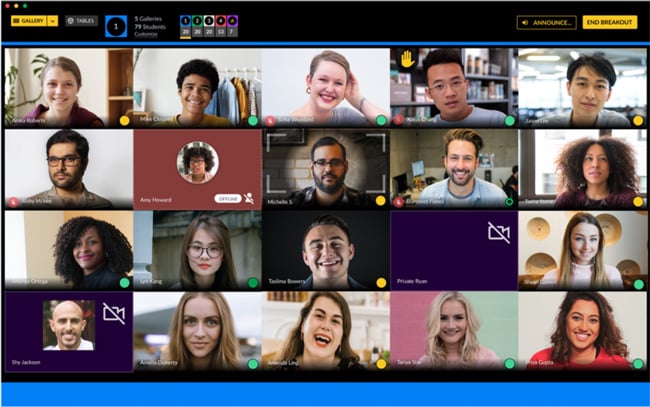New edtech startups aim to reinvent the online classroom
- Four new edtech platforms are made specifically for classroom use and designed to stimulate engagement and better learning outcomes
- The startups have rolled out incredibly quickly with the backing of major investment capital
The chaos of 2020 forced educators to quickly adopt video conferencing tools such as Zoom and Google Meet to teach their students remotely – but most of these tools were not specifically built for education. It hasn’t taken long, however, for a new generation of edtech providers to enter the marketplace. Many of the new platforms are well financed and scaling up quickly. We’ll focus on four today: Class Technologies, Engageli, Top Hat, and InSpace.
These new platforms are designed to solve a number of issues that teachers, parents, and students have encountered during COVID, including:
- Huge class sizes in which students often don’t feel comfortable, or even capable, of asking questions or interacting with their peers;
- Engagement problems – such as students becoming bored, distracted, or frustrated – that instructors either can’t see or can’t really address;
- Teaching done mainly through virtual presentations or lectures with little room for class participation or group work – a format that can be boring and one-dimensional for students sitting at home without the energy that comes from being in a physical classroom;
- Instructors feeling overwhelmed trying to connect with students through technology that isn’t built for teaching and learning.
A simple solution
Class Technologies is building teaching tools on top of the now well-established Zoom platform. It is designed for K-12 as well as higher education providers, and with simplicity in mind in order to maximise uptake among schools and teachers. This uptake is further assured because so many schools are already using Zoom; there’s a familiarity built into the concept. Features include new tools for:
- Taking attendance;
- Monitoring participation;
- Facilitating group discussion;
- Organising students by a seating chart;
- Handing out assignments;
- Giving a quiz;
- Enabling teachers to chat one-on-one with a student without interrupting other students.
All these capabilities happen within Zoom platform, so teachers don’t have to worry about integrating multiple technologies as they teach. The starting price is US$10,000 a year per school with prices scaling depending on the number of students in classes.
Class was founded by Michael Chasen, former CEO of Blackboard and is operating on a US$46 million venture round raised through a dream team of investors including Bill Tai (an early investor in Zoom) as well as Emergence Capital, GSV Ventures, Owl Ventures, and Reach Capital. Class expects to have 200 employees by the end of 2021.
Facilitating group work
Engageli, a videoconferencing platform for higher education, was created in California by the co-founder of Coursera (recently valued at US$2.5 billion), Daphne Koller, as well as her husband Dan Avida, Jamie Nacht Farrell, and Serge Plotkin. The idea for the startup came from Ms Koller and Mr Avida watching their teenage daughters learning on Zoom last year. Ms Koller told Forbes that, “We caught one of them in the middle of class playing Sims, and the other one watching a Netflix video … we started talking about how great the need was for something other than Zoom.”
The startup has raised at least US$14.5 million, and it stands out especially because it addresses the major problems of large class sizes and limited group interaction. There is more of a learning curve for teachers compared to platforms like Zoom, but the founders say the greater complexity is worth it because of what Engageli allows professors and students to do.
Engageli uses a “table” metaphor that allows professors to break students into small groups of 10 or fewer students who then work together on projects. Professors can come in and sit at the table to help out and keep everyone on track, and they’re more able to see how students are doing because they’re looking at a small group of students’ faces – not an entire classroom.
There’s also a neat study aid integrated into Engageli. Within the platform, students can screenshot slides and write notes on them, and these slides are hyperlinked so students can go back to the live recording associated with their note.
Engageli includes some of the same engagement features as Class such as the ability to give quizzes and polls and to see how students are participating individually and in groups. It is also built with the way students really interact with each other in mind – for example, it allows students to text each other or the entire class as they work, and students can also send the professor emojis to quickly communicate if they are having trouble understanding something or needing help.

Not trying to replicate the in-class environment
Top Hat has raised US$130 million so far and is based on delivering content through pre-recorded video. CEO Mike Silagadze says that Top Hat experimented with a virtual classroom concept initially, but “very quickly learned that it was fundamentally just the wrong strategy.”
Top Hat embraces asynchronous content delivery and is particularly interesting for international learners across time zones: Mr Silagadze believes that “nobody wants to stare at a screen and then have the restraint of having to show up at a previous pre-prescribed time.” He thinks that after COVID, universities are going to embrace the hybrid model: they’ll invest heavily in the instruction and experience students can get in person and use online tools to supplement face-to-face learning.
Top Hat digitises textbooks – but in an interactive way, with polls and interactive graphics embedded in the text. The company also launched a complementary product last year called Community, which is a virtual meeting space for teachers and students to connect and discuss assignments; it has private channels as well for one-one-one conversations.
By teachers, for teachers
InSpace was created in the US “by teachers, for teachers” by Dr Narine Hall, a Data Science and Machine Learning professor at Champlain College. Ms Hall says, “In the spring, when I was trying to do teamwork in the classroom, it was nearly impossible. So I decided to sit down and code a solution myself.”
InSpace (now a private company) allows students and professors to move around their virtual classroom, zoom in and out, and adjust audio settings. Instead of being fixed in a “Brady Bunch” box like in Zoom, students and professors are represented in a little circle with their photo in it and they can click and drag this circle around the classroom to participate in labs or discussions. When they move closer to someone or a group, they hear that person or group more clearly as if they were really sitting beside them, and when they move away, that conversation fades away so they can find new groups with which to interact. InSpace also allows for breakout rooms.
Dr Wibesa Wollega, an assistant professor at Colorado State University Pueblo, says he likes InSpace because its features “are designed to represent the coziness of a classroom environment especially with the ease of moving around the classroom.”
Ms Hall told Forbes,
“You can freely move around and feel the space. You get social cues through movement of video circles, like when I come close to someone, they know I want to talk to them. It’s a socially sensitive platform.”
For additional background, please see:















